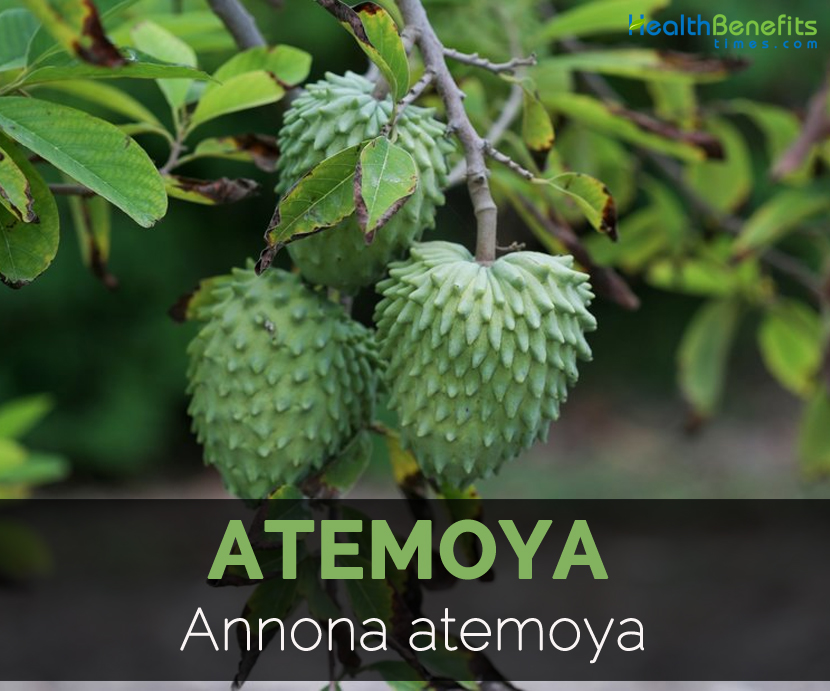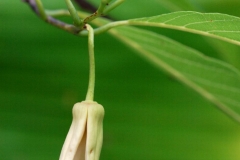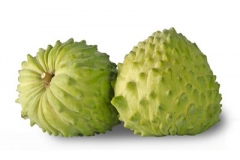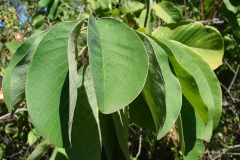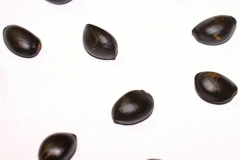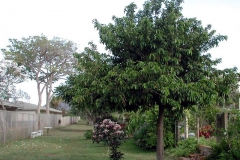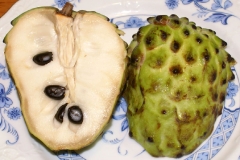Plant description
Atemoya is a small tree which grows to the height of 8 meters with short trunk and low drooping branches. Leaves are alternate, deciduous, leathery, elliptical and slightly pubescent measuring 15 cm long. Flowers are solitary, axillary which forms in clusters of 2 to 3, triangular, yellow and 6 cm long by 4–5 cm wide. Flowers has convex or cone shaped receptacle which contains numerous carpels at the top half and androecium in the lower circumference of the receptacle which is encased by 3 to 4 sepals. Fruit is a fleshy syncarp formed by fusion of carpels and receptacle. Fruit is heart shaped or conical, 8–12 cm long by 9–10 cm wide weighing 2–2.5 kg. Fruits are pale bluish-green to pea-green and slightly yellowish between areoles. Rind is 3–4 mm thick which consists of fused, prominent and angular areoles having rounded and slightly upturned tips, pliable, firm and indehiscent. Flesh is fragrant and solid divided into segments having few seeds than sugar apple. Seeds are hard, smooth, cylindrical and about 2 cm by 1 cm.
Leaves
Leaves are hairy and green when young and become smooth when mature. It is elliptic, ovate or lanceolate in shape. Leaves are 4 to 8 inches (10-20 cm) long and 1.5 to 3.25 inches (4–8 cm) wide.
Flowers
Flowers arise during mid to late spring. Flowers form singly or in 2-4 clusters from leaf axils on one year old shoots or new growth. Flowers are green with fleshy petals and 3 small and inconspicuous sepals and unicarpellate pistils on common receptacle.
Fruit
Fruit is conical to ovate and about 3-5 inches in diameter weighing 8 to 32 oz (227–908 g). The surface of the fruit is smooth, bumpy and possesses pronounced protuberances. The color of the fruit changes from green to yellowish green as the fruit matures. Pulp is white or creamy with custard like consistency and sweet or pleasant flavor. The fruit has 10 to 40 small, shiny and dark brown seeds.
Origin
The first cross was formed by P.J., a horticulturist in 1908. In 1917, the hybrid fruit was grown at the Plant Introduction Station in Miami, Edward Simmons. The tree survived at 26.5ºF temperature showing the hardiness.
Health Benefits of Atemoya
- Cure the cold
Atemoya lowers severity of cold symptoms and antihistamine that lowers unpleasant effects of common cold that includes inflammation, pain and runny nose. It controls allergy that causes cold. It lowers histamine level and lowers duration of cold.
- Digestive health
The fruit is rich in fiber that assists proper functioning of intestines that facilitate digestion process.
- Repel Insects
Mix crushed atemoya dried pulp with water and let it remain for few days.
- Relieve stress
Atemoya has Vitamin C in it which assist the body to cope with stress by lowering high stress levels, cortisol and hormones.
- Antioxidant activity
Atemoya has antioxidant in it which protects the body from oxidative stress and cellular rust that could lead to various severe medical conditions such as atherosclerosis which could result stroke and heart attack.
- Hypertension
The fruit reduces blood pressure and lowers the chances of hypertension and serious health problems that could result high blood pressure.
- Fiber Supplier
Fruit has high content of fiber which decreases sugar absorption.
- Intestinal health
Fruit comprises many fibers which is effective for constipation. It supports intestinal functions providing the feeling of satiety after ingested. The fruit has positive effects on the body lowering absorption of fats and sugars.
- Reduce cholesterol
Atemoya has diuretic fiber and niacin which is helpful in lowering cholesterol.
- Fight Anemia
Atemoya has iron in it that helps in preventing anemia.
- Manage diabetes
Atemoya has fiber which causes sugar to get absorbed slowly by the body and also prevents the onset of type 2 diabetes.
- Regulate Blood Pressure
The pulp has potassium that helps in lowering blood pressure. The body uses this mineral to balance water and potassium which is necessary for muscle contraction.
- Supplies vitamins
Atemoya is rich in vitamins namely Vitamin B1, C, B2, potassium, calcium and iron.
Culinary uses
- Pulp is consumed fresh.
- Use the pulp to make sherbets, juice, yogurt, shakes and ice cream.
- Add the pulp slices to fruit cups, salads and various dessert recipes.
- Blend with lime juice, orange juice, cream or frozen as ice cream.
Side effects
Seeds have toxins in it so discard it before consuming. The seeds when damaged, the toxins may reach the flesh.
Other facts
- The trees produce fruit in 3-5 years.
- Initially the fruits are green or light green which turns yellowish green when ripened.
- Fruits are round or oval shaped and about 7.5 to 12 centimeter in size.
References:
https://edis.ifas.ufl.edu/pdffiles/MG/MG33200.pdf
https://www.onlyfoods.net/atemoya.html
Comments
| Atemoya Quick Facts | |
|---|---|
| Name: | Atemoya |
| Scientific Name: | Annona atemoya |
| Origin | Native to South America. It is also found in Central American countries, Caribbean islands and United States (especially in Florida). |
| Colors | Pale bluish-green to pea-green |
| Shapes | Conical or heart-shaped, 8–12 cm long by 9–10 cm wide |
| Flesh colors | White |
| Taste | Similar to fruity vanilla |
| Name | Atemoya |
|---|---|
| Scientific Name | Annona atemoya |
| Native | Native to South America. It is also found in Central American countries, Caribbean islands and United States (especially in Florida). |
| Common/English Name | Custard Apple, Atemoya, Pineapple Sweetsop |
| Name in Other Languages | Cuba: Mammon, Mamon; Lebanon: Achta; Russia: Atemoyia, Spanish: Atemoya; Venezuela: Chirimorinon; Vietnam: Mãng Cầu Dai; Taiwan: Pineapple sugar apple; Israel: Anona |
| Plant Growth Habit | Small tree, vigorous, fast-growing |
| Soil | Dry or half moist |
| Plant Size | 8 m high |
| Leaf | Elliptical, leathery, up to 15 cm long |
| Flowering Season | Mid spring to late spring |
| Flower | Yellow, 6 cm long by 4–5 cm wide |
| Fruit shape & size | Conical or heart-shaped, 8–12 cm long by 9–10 cm wide |
| Fruit weight | 2–2.5 kg |
| Fruit color | Pale bluish-green to pea-green |
| Pulp | White |
| Rind | Thick |
| Fruit Taste | Similar to fruity vanilla |
| Seed | Cylindrical, 2 cm by 1 cm, dark brown to black |


